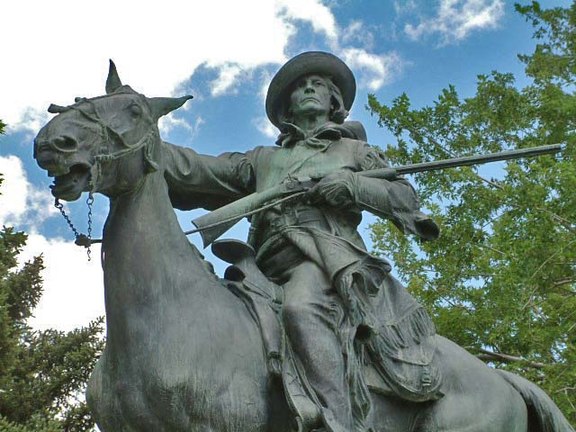- CountryUS
- Town:CO Trinidad
-
Year of creation:1913
- Rider(s):Carson, Kit
(1809 –1868), better known as Kit Carson, was an American frontiersman. He was a fur trapper, wilderness guide, Indian agent, and U.S. Army officer. He became a frontier legend in his own lifetime.
Carson left home in rural Missouri at 16 to become a mountain man and trapper in the West. In the 1830s, he accompanied Ewing Young on an expedition to Mexican California and joined fur-trapping expeditions into the Rocky Mountains. He lived among and married into the Arapaho and Cheyenne tribes.
In the 1840s, Carson was hired as a guide by John C. Frémont, whose expeditions covered much of California, Oregon, and the Great Basin area. Frémont mapped and wrote reports and commentaries on the Oregon Trail to assist and encourage westward-bound pioneers, and Carson achieved national fame through those accounts. Under Frémont’s command, Carson participated in the conquest of California from Mexico at the beginning of the Mexican–American War. Later in the war, Carson was a scout and courier who was celebrated for his rescue mission after the Battle of San Pasqual and for his coast-to-coast journey from California to Washington, DC, to deliver news of the conflict in California to the government.
During the American Civil War, Carson led a regiment of mostly-Hispanic volunteers from New Mexico on the side of the Union at the Battle of Valverde in 1862. When the Confederate threat was eliminated in New Mexico, Carson led forces to suppress the Navajo, Mescalero Apache, Kiowa, and Comanche tribes by destroying their food sources.
In recent years, Kit Carson has also become a symbol of the American nation’s mistreatment of its indigenous peoples.
- Sculptor(s):Lukeman and Roth
Henry Augustus Lukeman (1872 –1935), who sculpted the rider, was an American sculptor, specializing in historical monuments.
Roth, Frederick George Richard (1872 – 1944), who did the horse, was an American sculptor and animalier.
-
The statue of frontiersman Kit Carson was vandalised in 2020. Someone wrote the word “murderer” across the front and back of the base in black spray paint. The statue was first installed in 1913 to honor Carson’s role in Westward expansion. But as historical statues from all over the country have come under attack, representatives of the American Indian Movement have called Kit Carson an Indian murderer








